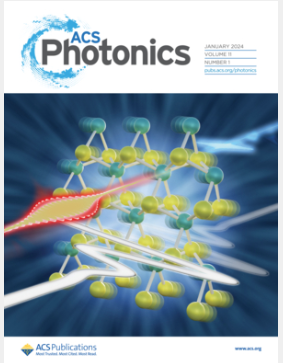atoliter Mie虚空传感
IF 6.5
1区 物理与天体物理
Q1 MATERIALS SCIENCE, MULTIDISCIPLINARY
引用次数: 0
摘要
传统的纳米光子传感方案利用电介质或金属纳米粒子中的倏逝场,这限制了远场辐射在色散和有损介质中的传播。除了缺乏明确定义的传感体积外,这些结构还受到模态场的普遍限制,而模态场是传感性能的一个关键方面。近年来,研究人员提出了一种新的介电纳米光子学策略,即光在空气中的共振约束。在高折射率介质主体材料中产生的所谓Mie空洞支持具有特殊性质的局域谐振模式。特别是,这些结构受益于完全进入强限制在空隙内的模态场。我们利用这些Mie空腔在单个空腔中进行折射率传感,其体积低至100升,每个折射率单位的灵敏度约为400 nm。考虑到我们测量的噪声,我们演示了在仅为390升的定义体积中检测到的折射率变化小至1 × 10-3。我们的Mie空隙传感器平台与适当的表面功能化相结合,甚至可以在保持灵敏度的同时,对最小体积的生物或其他分析物具有特异性。本文章由计算机程序翻译,如有差异,请以英文原文为准。

Attoliter Mie Void Sensing
Traditional nanophotonic sensing schemes utilize evanescent fields in dielectric or metallic nanoparticles, which confine far-field radiation in dispersive and lossy media. Apart from the lack of a well-defined sensing volume, these structures suffer from the generally limited access to the modal field, which is one key aspect for sensing performance. Recently, a novel strategy for dielectric nanophotonics has been demonstrated, namely, the resonant confinement of light in air. So-called Mie voids created in high-index dielectric host materials support localized resonant modes with exceptional properties. In particular, these structures benefit from the full access to the modal field confined strongly inside the void. We utilize these Mie voids for refractive index sensing in single voids with volumes down to 100 attoliters and sensitivities on the order of 400 nm per refractive index unit. Taking the noise of our measurements into account, we demonstrate detection of refractive index changes as small as 1 × 10–3 in a defined volume of just 390 attoliters. The combination of our Mie void sensor platform with appropriate surface functionalization will even enable specificity to biological or other analytes of smallest volumes while maintaining said sensitivity.
求助全文
通过发布文献求助,成功后即可免费获取论文全文。
去求助
来源期刊

ACS Photonics
NANOSCIENCE & NANOTECHNOLOGY-MATERIALS SCIENCE, MULTIDISCIPLINARY
CiteScore
11.90
自引率
5.70%
发文量
438
审稿时长
2.3 months
期刊介绍:
Published as soon as accepted and summarized in monthly issues, ACS Photonics will publish Research Articles, Letters, Perspectives, and Reviews, to encompass the full scope of published research in this field.
 求助内容:
求助内容: 应助结果提醒方式:
应助结果提醒方式:


